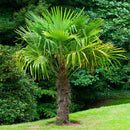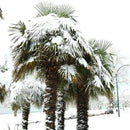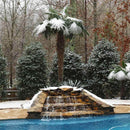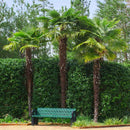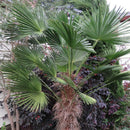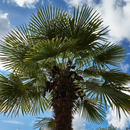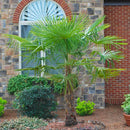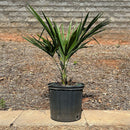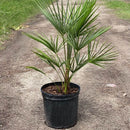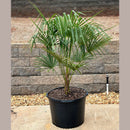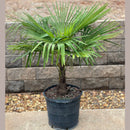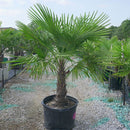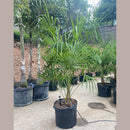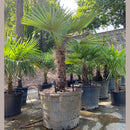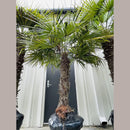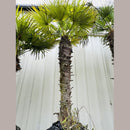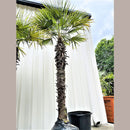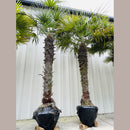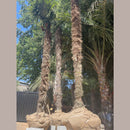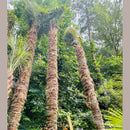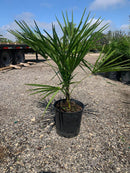| Grows Well In Zones: | 7-11 Outdoors |
| Mature Height: | 18-30 ft |
| Mature Width: | 7-10 ft |
| Sunlight: | Full Sun to Partial Shade |
| Growth Rate: | Slow |
| Shape: | Tree |
| Placement: | Outdoors |
Cold-Hardy charm
The Windmill Palm tree is a tough and attractive palm, and our top pick for the ultimate cold-hardy palm. With its towering trunk and fronds at the top, the windmill palm tree not only boasts the classic palm appearance but also withstands cooler temperatures better than most palm varieties, adding a tropical touch to any landscape.
Originally from eastern Asia, Windmill Palms radiate beauty whether they stand 4 or 20 feet tall. Despite their slow growth rate, they maintain their visual appeal at every stage of development, and grow to heights of 20-40 feet. Windmill palm trees are particularly beautiful when planted in groups of varying heights, but also make a stunning single accent palm.
Easy to care for and renowned for their resistance to disease and pests, these palms withstand sustained temperatures of 10°F with short drops to 0°F, and thrive in a variety of soils and climates, making them the perfect choice for those seeking a tall growing low-maintenance palm.
Windmill Palms have a single trunk covered in hairy fibers, which provide an additional layer of protection from the harsh winter weather. They are topped with 3-foot wide, dark green, fan-like fronds that form an evergreen canopy resembling the blades of a windmill.
The Windmill Palm, with its resilience and captivating beauty, will surely turn any area into a sunning tropical oasis.
Buy a Windmill Palm Tree Today
When you are looking at Windmill Palms for sale, it is important to go with a company that will stand behind its product. Our Windmill Palms for sale are backed up by our Perfect Palm Guarantee™, so if you aren’t satisfied with the health or quality of your Windmill Palm Tree within 365 days of receiving your palm, we will make it right! Find the perfect Windmill Palm Tree for sale at Atlanta Palms!
Q: How big does the Windmill Palm get?
A: The Windmill Palm can reach heights of 20-40 ft, depending on the conditions where it is planted.
Q: Can the Windmill Palm be planted near a house?
A: Yes! One of the benefits plants have over trees are that they have fibrous root systems (thin and short root system that grows superficial) that will not damage plumbing, sidewalks or any other structure.
Q: Can Windmill Palms be planted close to each other?
A: Yes! In fact, one of the nicest combinations for Windmill Palms are planting them in staggering sizes very close together, that way they grow tall together but the fronds do not compact against each other.
1. Sunlight
Windmill Palms prefer full sun, but they can tolerate locations with partial sunlight as well.
2. Water
- For the first month, water twice a week. After it is established, water once a week unless it rains.
- Watering needs to be thorough to make sure the bottom roots receive water at every watering.
- Space out watering sessions so the roots are able to dry.
- The amount of water needed per palm per watering session is equivalent to the volume of the planting hole that was dug for each palm. This amount may range from 2 gallons for small containerized material to 15 gallons for larger palms.
- Plants in a container need more constant watering than those planted on the ground.
- Overwatering or bad drainage can cause permanent damage to the roots over time.
- Placing mulch over the roots can help with water retention. Use caution not to allow the mulch to touch the base of the palm, otherwise it can cause rot.
Seasonal watering changes:
Depending on your geographic location and the intensity of the season, you may need to adjust watering accordingly:
Winter: (60 degrees or less) no need to water, except for the first 30 days after installation.
Spring: (75 degrees or less) Once a week.
Beginning of Summer: (90 degrees or less) Twice a week.
Heat of Summer: (90 degrees and above) Three times a week.
3. Fertilization
Windmill Palms should be fertilized three times a year in the Spring, Summer and Fall. Use a general purpose blend specific to palms, and be sure to follow the instructions on the label.
4. Soil
Windmill Palms tolerate most soils, as long as they drain well. To improve drainage combine 70% soil with 30% coarse sand.
5. Pruning
It is not necessary to prune your Windmill Palm. When a frond dies, it will detach and fall off on its own. If you do decide to prune your palm, be sure to prune the fronds that are damaged and mostly brown at the base of the stem. Do not remove any green fronds, as this can weaken the palm.
6. Winter Care
Wrap trunk with thick blanket and if possible, wrap incandescent lights around the blanket for added heat. If possible, cover fronds with a frost blanket.
SPEACIAL CONSIDERATIONS
Windmill Palms 30 gallons or smaller require more Winter protection than the more mature trees. If possible, spray with leaf protectant spray and cover fronds with a frost resistant blanket for temperatures under 0°F.
Customer Reviews
Payment & Security
Your payment information is processed securely. We do not store credit card details nor have access to your credit card information.























